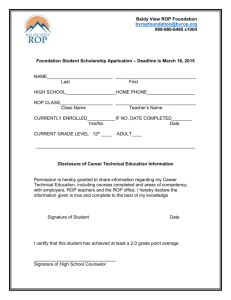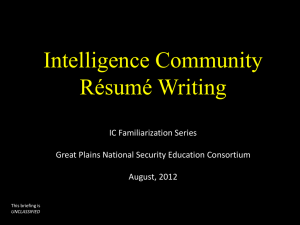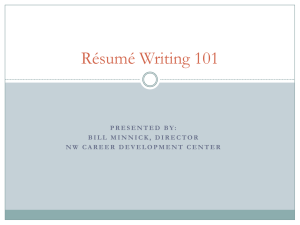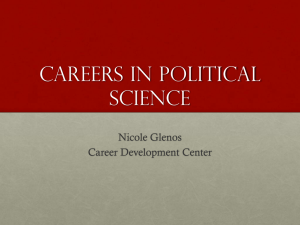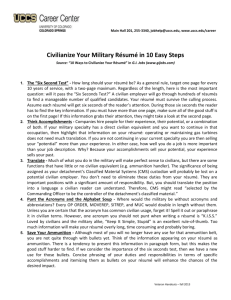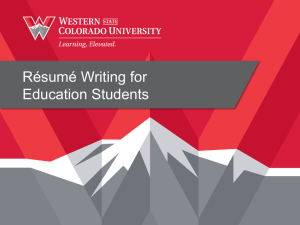Résumé Workshop for Culinary Arts
advertisement
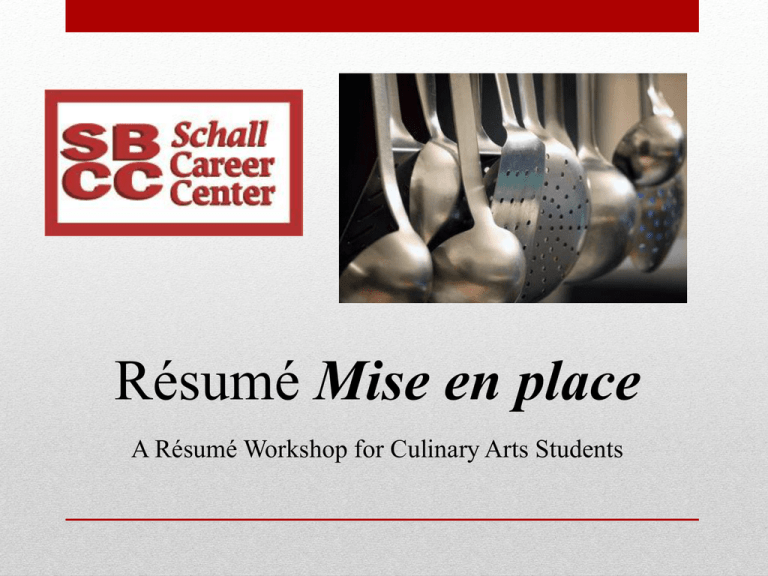
Résumé Mise en place A Résumé Workshop for Culinary Arts Students What is a Résumé? • A marketing tool – you are marketing yourself • A brief overview of education and relevant activities to demonstrate skills and accomplishments • A document tailored to each position / organization • The first (and maybe the only) impression • Let’s look at some Résumé Writing Guidelines • YOU MUST TELL THE TRUTH!! • Résumés are subjective– few true rules • What you include & HOW you include it, has an impact • Prioritize the information in order of interest to your reader– top left is highest emphasis Linking Yourself to the Position • This is the key to success • Match YOUR skills & qualifications to THEIR requirements and keywords • Critique your résumé as if YOU were the employer– what would YOU want to see? This is the single most important aspect of résumé writing! For Example… • Conduct training for personnel • Cook in quantity • Direct and coordinate food or beverage preparation • Monitor worker performance • Cook meals • Investigate customer complaints • Maintain production or work records • Price items on menu • Determine food or beverage costs • Modify work procedures or processes to meet deadlines • Schedule employee work hours • Direct and coordinate activities of workers or staff • Estimate materials or labor requirements • Use oral or written communication techniques • Inspect facilities or equipment for regulatory compliance Résumé Journal • You do amazing things every day in the culinary program • Though often we forget experiences quickly • A resume journal is an informal list of experiences and accomplishments • This will make customizing your resume for specific positions much easier! Parts of a Résumé : Contact Info Emphasize your Name Use a local address if reliable Phone numbers: use cell phone number if you have a professional voice mail greeting Provide appropriate e-mail address (NOT lazyboybob@...) and check on a daily basis Recommend 10-12 font size for contact information and remainder of résumé Parts of a Résumé: Objective Statement I want a job with a company who will value me and allow me to grow and gain experience. vs. • Seeking a Sous Chef position with Bacara Resort & Spa, utilizing my food styling skills for banquet, buffet and a la carte presentation. or • Seeking Sous Chef position at Barcara Resort & Spa Parts of a Résumé: Summary of Qualifications • Summarize your key strengths for the position • Can be called other things: Professional Profile, Culinary Excellence, Culinary Highlights • Not too many items (Roughly 3-5) • Be specific – paint a picture • This area should be ESPECIALLY tailored to position • Speak THEIR language Parts of a Résumé: Education • Don’t underestimate the importance of your education on your résumé • Think in terms of skills and experience...just like describing professional experience • List coursework and projects when applicable • SBCC can be your calling card Education Example Santa Barbara City College, Santa Barbara, CA A.S., Culinary Arts, Santa Barbara City College, Santa Barbara, CA, Expected graduation date: May 20XX Honors: 3.6 GPA, Dean’s List (2 terms) Related Coursework: Hospitality Sanitation & Safety, Principles of Baking, Purchasing & Receiving Special Projects: Vegetable and fruit carving demonstration, Pulled sugar competition. Parts of a Résumé: Experience • BE CONSISTENT • Include: Title, Organization, City, State, Dates • Include accomplishments rather than duties in bullet form • If your job title is not descriptive, consider replacing it with a functional title (Student Worker III = Asst Mgr of Graphics Lab) • Note: Your degree is your “job title” under Education (i.e. AA, Graphic Design) Describing Work Experience Focus on accomplishments, not routine duties Use ACTION verbs – created, managed, coordinated... Use numbers (numerals) whenever you can: $9800, 7 clients, 45% Use a superlative whenever you can: first, best, fastest, largest Write long on your first draft - you can edit later Take a Management Point of View Provide budget data even if that did not personally interest you Show some understanding of how your task fit into the company’s overall goals “Resulted in 5% reduction in inventory due to more efficient logistics, representing a one-time $5,000,000 savings to company Are you contributing to the “bottom line” or goals of the business? Experience Example #1 1997-1999 Swersky Construction, Santa Barbara, CA Bob Swersky, Supervisor 1235 Overlook Drive 805-620-7314 Labourer– hammered nails, thumbs; mastered expletives Experience Example #2 Construction Crew Assistant, Swersky Construction, Santa Barbara, CA Summers 2007-2009 • • • • Coordinated with crew of 4 to build homes Rapidly adapted to changing work orders Maintained tools worth over $1000 Beginning training in reading blueprints and structural requirements Parts of a Résumé: Other Sections • Campus/Community Involvement • This is one example...think of some of your own • References • They are assumed; use the space to expand on your qualifications • Create a reference list (with professional and/or scholastic contacts) to give them when they do ask, but not before. Résumé Formatting • Chronological? Functional? Combination? • Length: ONE PAGE? • Font and margin considerations • Use bold type, italics, or underlines to highlight important information • Your résumé should be NEAT, PROFESSIONAL and EASY TO READ • Absolutely NO typographical errors! Chronological Format • Advantages • • • • It’s the most common & traditional style. Employers find it easy to understand. It’s generally easier to write. It emphasizes career laddering. • Disadvantages • Most recent experience may not be your most important or relevant experience. • May have little or no work experience or feel their work experience is unimpressive. • Don’t want to be stereotyped on the basis of past work experience. Functional Format • Advantages • Useful when you want to emphasize abilities not used in recent work experience. • May be useful when entering the job market for the first time or changing careers. • Disadvantages • May be difficult to write. • May be confusing to employer or create skepticism due to lack of content. Do Emphasize your name Be consistent Use numbers Match keywords to the job posting Describe projects TELL THE TRUTH! Don’t Use the word “I” Use fluff phrases– e.g., Responsible for, Duties include, etc. Use graphics or colors or photos Allow ANY spelling or grammar errors Have fun! Come to the Career Center if you need help or want your résumé reviewed.




